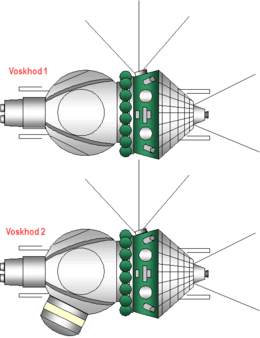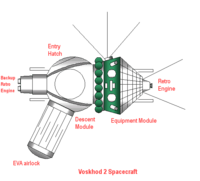Voskhod programme

The Voskhod program (Russian: Восхо́д, IPA: [vɐsˈxot], Ascent or Dawn) was the second Soviet human spaceflight project. Two manned missions were flown using the Voskhod spacecraft and rocket, one in 1964 and one in 1965.
Voskhod development was both a follow-on to the Vostok programme and a recycling of components left over from that programme's cancellation following its first six flights. The Voskhod programme was superseded by the Soyuz programme.
Design
The Voskhod spacecraft was basically a Vostok spacecraft that had a backup, solid-fueled retrorocket added to the top of the descent module. As it was much heavier, the launch vehicle would be the 11A57, a Molniya 8K78M with the Blok L stage removed and later the basis of the Soyuz booster. The ejection seat was removed and two or three crew couches were added to the interior at a 90-degree angle to that of the Vostok crew position. However, the position of the in-flight controls was not changed, so the crew had to crane their heads 90 degrees to see the instruments.
In the case of Voskhod 2, an inflatable exterior airlock was also added to the descent module opposite the entry hatch. The airlock was jettisoned after use. This apparatus was needed because the vehicle avionics and environmental systems were air-cooled, and depressurization in orbit would cause overheating. A solid-fueled braking rocket was also added to the parachute lines to provide for a softer landing at touchdown. This was necessary because, unlike the Vostok, the Voskhod descent module landed with the crewmen still inside.
Unlike Vostok and the later Soyuz, Voskhod had no launch abort system, meaning that the crew lacked any means of escape from a malfunctioning launch vehicle.
Voskhod had a solid-fueled backup retrorocket on top of the capsule in case the main one failed (as it did on Voskhod 2). While Vostok lacked this feature, it was not considered a problem since the spacecraft would decay from orbit within 10 days. Relatively lightweight Voskhod was well below the 11A57 booster's lift capacity, meaning that it launched into a much higher orbit and would not decay as quickly.
Comparison with Gemini
After the first-generation Vostok and Mercury capsules had proved the technical feasibility of manned spaceflight, NASA proceeded to build its second-generation spacecraft, Gemini. The capsule was of a completely new design, retaining the conical, shingled nickel alloy walls and fiberglass ablative heat shield of Mercury, while adding several new features. These included: a set of translation control thrusters to allow altering orbit, and changing position relative to another craft for docking; hydrogen/oxygen fuel cells to generate electrical power for up to fourteen days; a radar system for use in space rendezvous with another craft; and dual outward-opening ingress/egress doors, and avionics which did not require a constantly pressurized cabin for cooling, which facilitated extra-vehicular activity (EVA). These features were useful in developing procedures used in the Apollo program manned lunar landings.
In comparison, Voskhod capsules were simply modified Vostok craft. No provisions for translation control, rendezvous or docking were made. In fact, Vostok's ejection seat launch escape system had to be removed, due to launch payload constraints, and the fact that two of the three cosmonaut couches did not align with the ingress/egress hatch. A complex, cumbersome inflatable airlock had to be stuffed into the cabin in place of one cosmonaut couch, in order to permit EVA. In the end, Voskhod turned out to be a dead end and was abandoned after only two manned missions. It was replaced by the more advanced Soyuz spacecraft.
Flights
The Voskhod flights, with launch dates:
Unmanned
- Kosmos 47 - Unmanned test flight of the Voskhod hardware.
- Kosmos 57 - Unmanned test flight, unsuccessful.
- Kosmos 110 - Unmanned, sent two dogs, Veterok and Ugolyok, on 22-day flight, launched 22 February 1966.
Manned
| Order | Mission | Launch | Duration | Landing | Crew | Notes | ||
|---|---|---|---|---|---|---|---|---|
| 1 | Voskhod 1 | 12 October 1964 | 1 d 0 h 17 m 3 s | 13 October 1964 | V. Komarov | K. Feoktistov | B. Yegorov | First multiman spacecraft. |
| 2 | Voskhod 2 | 18 March 1965 | 1 d 2 h 2 m 17 s | 19 March 1965 | P. Belyayev | A. Leonov | First spacewalk. | |
Cancelled
- Voskhod 3 - 19-day two-man mission to study long-term weightlessness with artificial gravity, medical, military and other experiments
- Voskhod 4 - 20-day single-man mission to study long-term weightlessness with artificial gravity, medical, military, and other experiments
- Voskhod 5 - 10-day two-woman mission with medical and other experiments and first female EVA-spacewalk
- Voskhod 6 - 15-day two-man mission with military and other experiments and multiple spacewalks to test new EVA jet belt
Results
While the Vostok program was dedicated more toward understanding the effects of space travel and microgravity on the human body, Voskhod's two flights were more aimed towards spectacular firsts. Although achieving the first EVA ("spacewalk") became the main success of the program, beating the U.S. Project Gemini to put the first multiman crew in orbit was the objective that initially motivated the program. After those goals were realized, the program planned to focus on other advances the spacecraft could accomplish, such as longer duration and a second female flight. However, there were delays preparing for Voskhod 3, and during that time the Gemini program accomplished most of what had been planned for future Voskhods.[1] In the end, the Voskhod program was abandoned, aided by a change in Soviet leadership which was less concerned about stunt and prestige flights, and this allowed the Soviet designers to concentrate on the Soyuz programme.
References
External links
| Wikimedia Commons has media related to Voskhod program. |
| ||||||||||||||||
| ||||||||||||||||||||||
Coordinates: 45°55′01″N 63°19′59″E / 45.917°N 63.333°E
